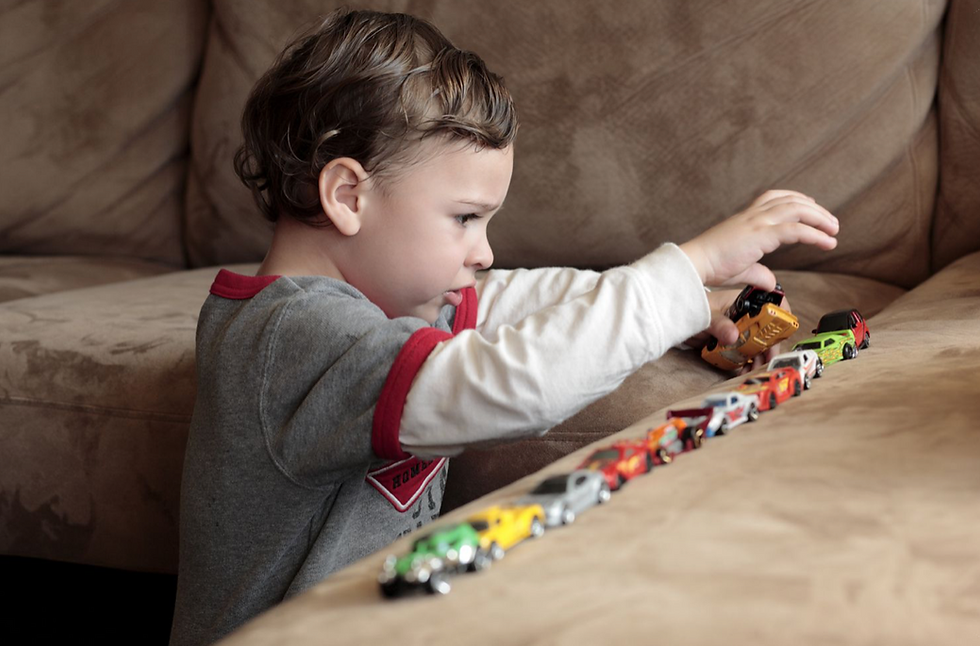Defining Autism in Media Representations
- Zach Smith

- Oct 29, 2020
- 7 min read
Updated: Nov 5, 2020

In our daily media consumption, we are met with the typical representations and stereotypes that look to create our social perceptions. Almost every time, the setup is the same. You have the masculine, dominant, and aggressive man, and the damsel-in-distress woman with too much makeup and skin showing. You also have men holding all of the leadership roles and women not having much intelligence because the focus is set on their looks. It is very easy for us to pick up the stereotypes because of how much they appear on our favorite shows and movies, especially children. Because they’re the most impressionable, kids can easily absorb the Hulk’s dominant persona, or try to match the revealing outfits as their Barbie dolls. Children should know from an early age that the representations are not always accurate and truthful, so they should not try to plant them into their minds thinking that is the way to act or appear. Adults should let kids be themselves and not think of the distorted stereotypes playing a role in their cognitive development. Giving them the green light to be themselves naturally will allow them to find their strengths and know the values for what their lives represent. Likewise, they will see others not for how they look, but the capabilities that make them who they are as human beings. Keeping an eye for exterior representations is vital, but interior representations play a pivotal role in how we look at how men and women communicate.
Portraying autism correctly in media representations is essential because incorrect accounts can lead to stereotypical thoughts in people’s minds. As an autistic individual, a few presentations of autism are not adequately presented, especially the case on Fox’s long-running show Family Guy. On two occasions, the show’s writers poked fun at autism and made light of it. In one episode, one of the main characters, Peter, was in a doctor’s office sitting next to an autistic woman who would scream every few seconds. In another episode, Peter banged two cymbals to see if his son, Chris, was autistic. These representations are inaccurate because they show that autistic people have no capabilities and don’t hold much value to society. Albeit some autism people are sensitive to loud noises, banging cymbals to someone’s ear is never an appropriate action take. Moreover, many autistic individuals are very knowledgeable. Autism Speaks notes that 44% of children with an autism spectrum disorder (ASD) have an average to above-average IQ. The setup of the Family Guy representations does not account for what autistic people can do as human beings.
Over the past few decades, and especially in recent years, the representations of characters with a disability have increased. Earlier this year, Freeform premiered the show Everything’s Gonna Be Okay, which follows a group of siblings, one with autism, in the wake of their father’s death. Kayla Cromer, who plays the autistic character, has autism herself, providing a realistic account of someone on the spectrum to the show’s writers and producers. Another show on ABC Australia, Love on the Spectrum, follows autistic couples through their dating lives. Other forms of media haven’t gone to the level of Family Guy, but they have exaggerated the presentation a bit too much. Examples such as Rain Man and The Big Bang Theory respectively gave Raymond Babbitt and Sheldon Cooper obvious quirks (i.e., no eye contact, dislike to change) that not all autistic individuals possess. Sure, some folks may struggle with those components, but they do not define people on the spectrum at all. The presentation that we receive from those media forms come from the writers and producers presenting autism from their eyes without bringing in perspective from someone with autism or Asperger syndrome. During my many years of media consumption, I have seen two superior examples of a show and a short film use autism appropriately, and showcase the aspects behind it. Both presentations show the common and accurate depictions of someone with autism and how he and she navigate daily life without showing negative limitations.

One brilliant example of an accurate autism depiction that I was impressed with came on the children’s TV show, Arthur. In the episode “When Carl Met George,” one of Arthur’s friends, George, meets a boy, Carl, who has Asperger’s. During their first interaction, George doesn’t realize that Carl has Asperger’s George walks by Carl as he’s doing a puzzle of a train, and George mistakes the train for a spaceship, and Carl explains that it’s actually a train. Carl shares his vast knowledge of trains with George, and he shows him a drawing of a train that he drew entirely from memory. As they finish up their conversation, George uses typical terminology we use in daily conversations, such as “hang out” and “pull my leg,” but Carl doesn’t understand what he says. This example goes along with how autistic individuals tend to go for the literal meaning instead of the figurative meaning behind certain expressions. The show’s writers are not bashing Carl in any way; they are highlighting the ways folks with autism or Asperger’s may interpret language, so adults and children can have an idea of how their brain works when processing information and words.
The next day they meet, George discovers from Carl’s mom that he has Asperger’s when he is frightened by George’s giraffe ventriloquist dummy. Carl goes into the corner of the room they’re in and makes a gasping sound while covering his ears. That incident does not go against Carl because many autistic people (including myself) use various coping mechanisms to help themselves relax in stressful situations. The show provides an accurate narrative that if someone tries to escape a stressful situation by covering his or her ears or practicing deep breathing, no one should ever criticize him or her in any way because he or she is doing what he or she is most comfortable with when doing meditating exercises to calm down. Later, George seeks the help of his friend, Alan, to understand more about Asperger’s. Alan provides an excellent account of Asperger’s, and explains how people on the spectrum think differently about any situation, and might interpret the messages than the average person. Putting himself in Carl’s shoes made George more aware of how he sees the world, and how not everyone thinks the same way. Near the end of the episode, George gives Carl a train book, and the two of them become terrificfriends as the show continues its run. I was extremely pleased with Arthur’s presentation of Asperger’s and autism because this shows kids that people on the spectrum are very bright and intelligent human beings with the same capabilities as everyone else. No one should ridicule an autistic person’s quirks or coping mechanisms if he or she struggles with certain components of life (i.e., loud noises, heavy workloads). One person may view his or her senses in a specific way, whereas someone else might try a different approach. Those are the blueprints that make all of us innovative individuals, and they are what make us successful in all we accomplish.

Another superb example of autism in the media is the short film Pixar came out with earlier this year titled Loop. Most autism representations are present white, verbal males, but the autistic character in Loop is female, African-American, and non-verbal. The film follows “a non-verbal autistic girl (Renee) and a chatty boy (Marcus) [who] are partnered on a canoeing trip. To complete their journey across an urban lake, they must both learn how the other experiences the world.” On their journey together, Marcus understands the various quirks that Renee has, which aren’t too overdramatized. She has repetitive behaviors, a common trait among autistic individuals, where she replays a barking-dog ringtone on her phone. Renee also likes the feel of the soft plants in the lake, where she has Marcus go out of the way for her to experience the soothing feeling. After Marcus brings Renee through a tunnel to experience the ringtone in an echo, her senses get overstimulated from a nearby motorboat and she takes an oar to rush out of the tunnel, where the two get thrown on to a nearby shore. Marcus gets upset with Renee for throwing them overboard, and she is so distraught by what happened that she hides under the canoe. After time passes, Marcus apologizes for his actions, and he gives her a small plant to help her relax. The two of them imitate the ringtone and head out on the canoe as closer friends.
I loved watching Marcus’s character flourish throughout the short because of how he got to understand the world through Renee’s point of view. He got to feel the plants to see how soft and comforting they felt and recognize her cues when she had to go to the bathroom (poop emoji on her phone) and when she wanted to feel the plants again (whimpering). The short’s writers did an outstanding job showcasing the interactions of an autistic person to someone not on the spectrum, where the two could understand each other’s feelings. Renee and Marcus did not take each for granted, and the two solved all of the problems they faced on their canoe trip. The writers also did well with not exaggerating quirks or tendencies with people on the spectrum. I felt they laid Renee’s characteristics out with no derogatory or insensitive representations. The writers gave Renee appropriate and realistic characteristics that you would expect from an autistic individual. Creating shorts like these create broader awareness of autism and how to understand anyone’s needs and feelings, as well as the friendships kids can make while doing so. Autistic individuals aren’t different at all from others not on the spectrum, so including them in daily activities makes them feel good about who they are and the worth they have in others’ lives and their own.

Presenting autism in the media the correct way can help everyone understand the characteristics that folks on the spectrum have. It is never fair to assume certain traits the way Family Guy did, nor exaggerate quirks as done by Rain Man. Writers and producers who use assumed or overdone representations paint the picture that autistic individuals act in certain manners, and make our perceptions go along with their beliefs. Going that route will make our society make false assumptions and beliefs about the true ways children and adults with autism or Asperger’s navigate their daily lives, which can take a big hit on their self-esteem. I would argue that having someone on the spectrum consult with writers and producers about a show or film with an autistic character can help add substance to the program’s validity of the representations. The approach that the writers and producers of Everything’s Gonna Be Okay have done should be followed by others in the making of entertaining programming for viewers of all ages. Consulting with an autistic person in developing a similar character will provide an excellent account of how individuals on the spectrum look, think, and do, and how they are successful in their accomplishments. People who have autism and Asperger’s are more intelligent than people realize, and it’s not that they have a disability; they have spectacular capabilities in all they do.
Sources used





Comments